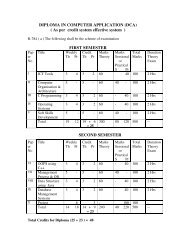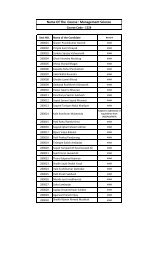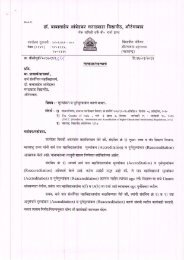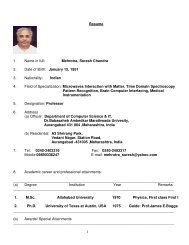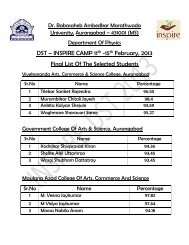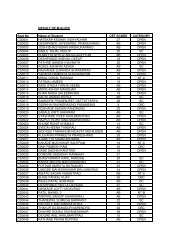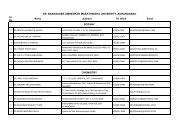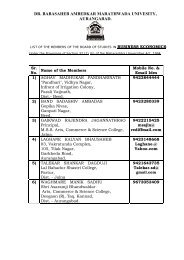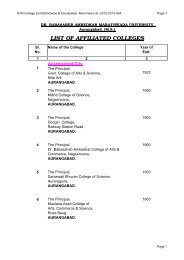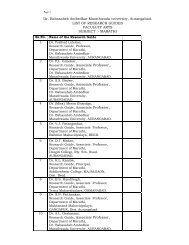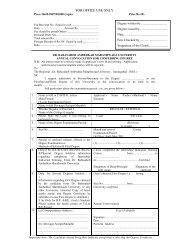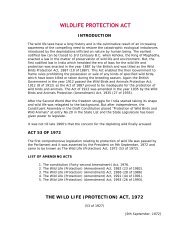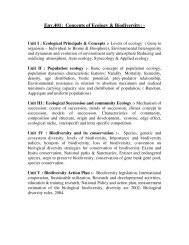1 Issue : 2 November 2011 - Dr.Babasaheb Ambedkar Marathwada ...
1 Issue : 2 November 2011 - Dr.Babasaheb Ambedkar Marathwada ...
1 Issue : 2 November 2011 - Dr.Babasaheb Ambedkar Marathwada ...
Create successful ePaper yourself
Turn your PDF publications into a flip-book with our unique Google optimized e-Paper software.
Innovative Systems Design and Engineering www.iiste.org<br />
ISSN 2222-1727 (Paper) ISSN 2222-2871 (Online)<br />
Vol 2, No 3<br />
The distillate produced in solar still unit III was 18.9 ml in first hour, 22.8 ml during 3rd hour, 19.2 ml<br />
during 5 th hour and just 11.5 during the 7 th hour of exposure. The productions during 3rd and 4th hours of<br />
exposure were almost same, 22.8 ml and 22 ml respectively. The cumulative distilled water production<br />
after 2 hours in solar still unit III was 70.2 ml and was increased to 111.4 ml after 5 hours, 127.4 ml after 6<br />
hours and finally to 138.9 ml after 7 hours of solar exposure.<br />
The percentage of distilled water out of total quantity of water taken in the solar still unit III was 0.90% in<br />
first hour, 2.25% after 2 hours, 3.345 after 3 hours, 4.38% after 4 hours, 5.29% after 5 hours and 6.06%<br />
after 6 hours of solar exposure during the test time. The total of 6.60% water was collected from solar still<br />
after 7 hours of solar exposure from solar still unit III. The results indicate that the efficiency was just<br />
0.70% in first hour. It was increased to 1.75% after 2 hours, 2.59% after 3 hours, 3.4% after 4 hours, 4.11%<br />
after 5 hours and 4.7% after 6 hours. The distillation efficiency after 7 hours of solar exposure was 5.13%<br />
in solar still unit III.<br />
The total quantity of distilled water produced per hour was higher in unit IV than other units. The<br />
maximum distilled water production of 31.2 ml /hour was observed in this unit between 11.30 am and<br />
12.30 pm. The cumulative volume of distilled water after 7 hours of solar energy exposure was 159.9 ml<br />
and the distilled water production efficiency was 5.16% from the initial volume of 2404 ml with the depth<br />
of 2 cm. The distillate volume produced in solar still unit IV was 31.2 ml during this interval. The<br />
production was 25.4 ml in third hour of exposure, 22.4 ml in 4 th hour, 21.3 ml in 5 th hour, 19.5 ml in 6 th<br />
hour and was minimum of 17.7 ml in 7 th hour. The cumulative distilled water production was found<br />
increasing in first hour of exposure and the rate of increase was higher in second hour causing little<br />
reduction in the rate of increase thereafter in each subsequent hour of exposure.<br />
The cumulative distillate generated was 52.6 ml after 2 hours, 79 ml after 3 hours, 101.4 ml after 4 hours,<br />
122.7 ml after 5 hours and 142.2 ml after 6 hours. The total of about 159.9 ml distilled water was produced<br />
after 7 hours of solar exposure in solar still unit IV. The percentage efficiency of distilled water produced in<br />
solar still unit IV indicates that the distilled water produced in first hour of distillation was 0.93% which<br />
subsequently increased to 2.23%, 3.29%, 4.22%, 5.1%, 5.92% and finally to 6.65% after 2 nd , 3 rd , 4 th , 5 th , 6 th ,<br />
and 7 th hours of solar exposure respectively.<br />
The results reveal that the production rate performance (PRP) was highest in unit IV and lowest in unit I. It<br />
is obvious that the total area of solar exposure was higher in unit IV resulting into higher PRP than the<br />
other units with less solar exposure area in other units. The highest rate of PRP was recorded between<br />
11.30 am and 12.30 noon in all the solar stills studied. It was 0.0287 L/m 2 /hr in unit I, 0.0288 L/m 2 /hr in<br />
unit II, 0.0279 L/m 2 /hr in unit III and 0.0267 L/m 2 /hr in unit IV. The results are graphically represented in<br />
Fig. 3 in a summarized for ease of comparison.<br />
The comparisons for cumulative distilled water production in different units of solar stills tested in present<br />
study are summarized in Fig. 3. The date generated reveals that the cumulative distillation rate with respect<br />
to time of exposure was higher in the unit IV followed by unit III, then unit II and was least in unit I among<br />
the tested solar still units.<br />
The distilled water production efficiency of different solar units during the solar irradiance is represented in<br />
Fig. 4. The results reveal that the distilled water production efficiency was marginally higher in the solar<br />
still having larger solar exposure surface area.<br />
The assessment of distilled water from solar still indicates that the solar distillation of water is not only<br />
competitive with commonly supplied drinking water but also it is highly competitive with the bottled<br />
drinking water as it is free from all organic and inorganic impurities. It can be used for various purposes<br />
like in energy storage batteries, preparation of chemical solutions in laboratory analysis, pure solvent and<br />
other uses.<br />
Removal of salts is compatible with distillation of common water by use of electrical distillation. The<br />
values of salts are zero and indicate that the removal of salts and metallic impurities are comparable with<br />
the bottled water in the market. The operation and maintenance is easier and no technical training is<br />
3



